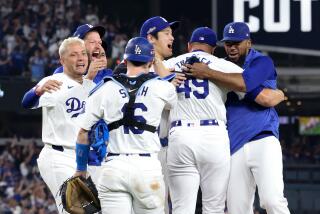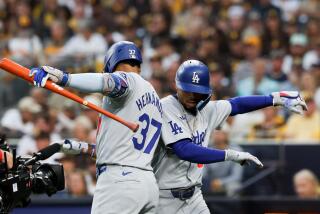Dodgers’ bats go cold in 4-0 loss to Padres

- Share via
The mere sight of San Diego pitcher Clayton Richard should not invite alarm. Richard is a credible performer, a veteran in his ninth major league season, but his fastball hovers around 90 mph and his career earned-run average resides above four. When the Cubs cut him last August, he landed with San Diego, a rebuilding club desperate for competence.
The singular gift of Richard, at least when it comes to facing the Dodgers, is his ability to throw the baseball with his left hand. Despite a series of offseason adjustments tailored toward resolving their most glaring weakness from 2016, the Dodgers looked like a mirror image of the past in a 4-0 loss to the Padres on Tuesday night at Dodger Stadium.
“I hate to go back to last year, but it feels like they were anxious at-bats against left-handers,” third baseman Justin Turner said. “Not waiting guys out, getting mistakes over the plate. But we’ll get better.”
One game does not create a trend. In the long view of the 162-game marathon, neither does one series or one week or perhaps even one month. But the outcome Tuesday matched the patterns of 2016, when the club pounded baseballs into the grass rather than sending them aloft. In Monday’s season opener, the Dodgers launched four home runs in a 14-3 victory. A day later, the lineup grounded into four double plays.
Richard limited his hosts to five singles in eight innings. He had not pitched that deep into a game since 2013. He retired the last eight men he faced. No Dodger reached second base. The steady stream of grounders rendered that pursuit difficult. After Kenta Maeda allowed three runs in five innings, the offense failed to touch the deficit.
Manager Dave Roberts and his players often became irritated by questions about left-handers last season. The Dodgers finished the year with the worst on-base-plus-slugging percentage in the majors against left-handers. To remedy this deficiency, the team acquired a pair of right-handed hitters in second baseman Logan Forsythe and outfielder Franklin Gutierrez. Both figure prominently in the club’s plans.
Forysthe led off Tuesday and Gutierrez was the cleanup hitter. After a 14-run flurry on Monday, Roberts toggled his lineup. The most notable adjustment involved the absence of Joc Pederson, who had hit a grand slam in the opener. During spring training, Roberts maintained his hope to use Pederson more often against left-handed pitchers. He prefers for Pederson to face lefties who rely upon velocity, and Richard didn’t fit the mold.
Richard quieted the Dodgers bats from the start. In the first four innings, he induced a trio of double plays. He needed 49 pitches to collect 12 outs, a pace that far outstripped Maeda’s.
“His goal is to put the ball on the ground,” Roberts said.
The top of the first inning lasted 17 minutes. Maeda required 29 pitches. He expended nine of those against first baseman Wil Myers, who flared a single into center field and put runners at the corners. A ground ball from San Diego second baseman Yangervis Solarte rolled past Forsythe for an RBI single. The next batter, third baseman Ryan Schmipf, popped out into shallow left field, where shortstop Corey Seager ran down the ball, but he could not whirl in time to throw out Myers on the sacrifice fly.
Maeda wobbled into the fifth. Unable to finesse his offspeed pitches, he sent a changeup down the middle to Solarte. Maeda looked skyward and chuckled as the ball took flight. The solo homer cleared the center-field fence. He would pitch only two more innings.
“It’s a long season,” Maeda said. “We still have a lot of games to play.”
In the fifth, Roberts sent Scott Van Slyke to bat for Maeda, with Enrique Hernandez at first after a walk. Van Slyke ripped a line drive toward the third-base side, but Schmipf snared it.
Forsythe reached base in all three appearances against Richard. He opened the sixth with his second single. After Seager flied out, Turner stepped to the plate. The third pitch of the at-bat was a changeup that dived toward Turner’s feet. He left the box and prepared to walk to first, but umpire Alfonso Marquez ruled the pitch hadn’t hit him and was merely a ball.
Turner pointed toward his eyes and signaled to his dugout. He removed his ankle guard as the umpires waited for the verdict on the replay challenge back in New York. His confidence could not offset the inconclusiveness of the footage. Two pitches later, Turner bounced another changeup into a fourth double play.
Turner watched the replay later in the night. He said he saw the ball change direction as it collided with his foot.
“There should be no inconclusive — there should be yes or no,” Turner said. “There shouldn’t be gray area, with all the slo-mo, all the cameras and how they can zoom in. There’s no way they should have so many inconclusive calls.”
As the Padres cobbled together a run against reliever Ross Stripling in the eighth, the San Diego bullpen showed no sign of activity. There was no reason to take the ball from Richard. He struck out catcher Yasmani Grandal with a changeup, got Hernandez to bounce a fastball into the ground and netted a checked-swing strikeout from backup catcher Austin Barnes on a slider. Richard removed his glove and waved beyond his dugout as he left the diamond.
For one night, facing a Dodgers lineup that must answer questions about the questions it could not answer in 2016, Richard looked triumphant.
“Quite honestly, if he was out there against any team,” Roberts said, “I think he would have had a lot of success.”
Twitter: @McCulloughTimes
More to Read
Are you a true-blue fan?
Get our Dodgers Dugout newsletter for insights, news and much more.
You may occasionally receive promotional content from the Los Angeles Times.











